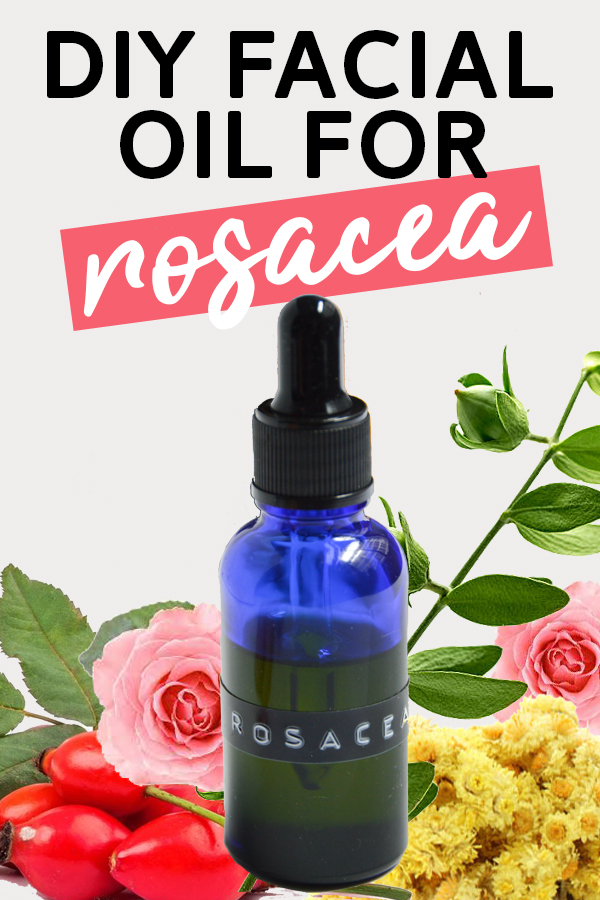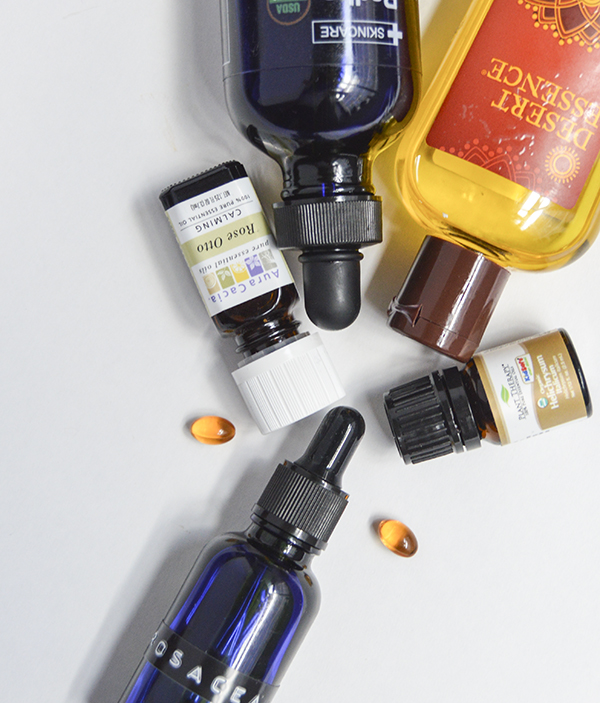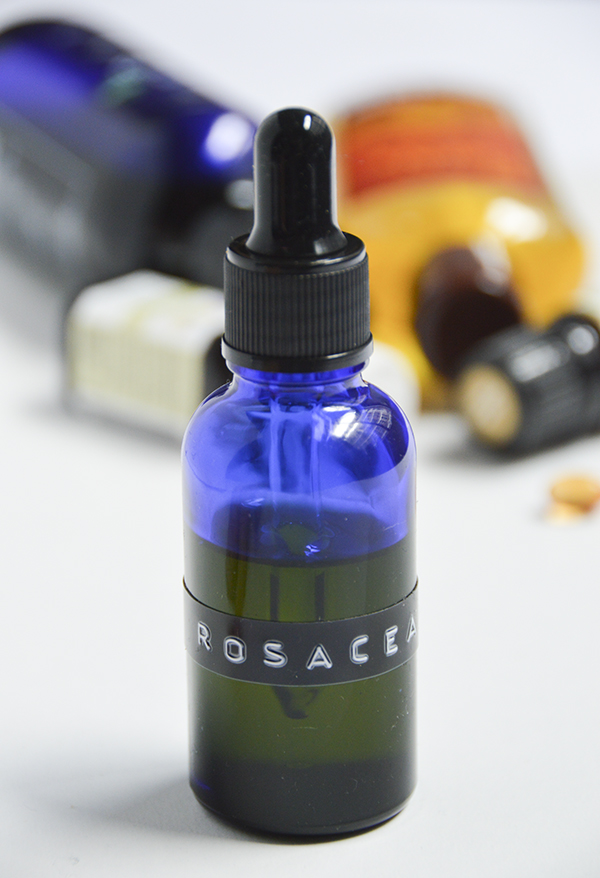
In this post I’ll be sharing the facial oil blend that I’ve personally been using for my rosacea (with awesome results!), but then we’ll go beyond that. Everyone’s skin and body is different, so instead of just sharing my facial oil for rosacea, I’m going to also help you build your own that suits your skin best.
For more background info on rosacea, my experience with it (before & after pics), and how aromatherapy can help, check out this blog post: Essential Oils for Rosacea. And before we jump into things, it’s important to emphasize that I am a Certified Aromatherapist, not a doctor. I 100% stand behind aromatherapy as a complementary therapy for rosacea, however the information shared in this post should not replace advice from your doctor.
My Facial Oil for Rosacea
Links throughout this post are mostly to Plant Therapy, a brand I personally use and love. If you prefer shopping on Amazon (don’t we all), I’ve also included links to the oils there. Your local Whole Foods probably carries Aura Cacia, and that’s another brand I love and would recommend. For other brand suggestions, check out this post. Below links are affiliate, but I’m in no way sponsored by any essential oil brand.
The following recipe makes 1oz of facial oil at a 2% essential oil dilution.
Blend Ingredients
- 1/2 oz (1 tbsp) Jojoba oil
- 1/2 oz (1 tbsp) Rosehip seed oil
- 8 drops Helichrysum
- 4 drops Rose otto
- 400 IU Vitamin E
Direction for Blending & Using
To assemble: Add your carriers and antioxidant (Vitamin E) then the essential oils, and shake to combine. Adding an antioxidant like Vitamin E to facial oil blends will prolong the shelf life—also Vitamin E is great for skin. You can buy a bottle of Vitamin E gels where ever you buy supplements and simply rip open the gel casing and squeeze it out into your blend.
Usage: Facial oils should be applied to moist skin after cleansing and toning, by putting a couple drops on fingertips and gently smoothing/pressing on in an upward motion. I apply twice a day, in the morning and before bed. If you also use a moisturizer, put the facial oil on before the moisturizer. I personally just use more carrier oil as a moisturizer after applying the facial oil blend (rosehip seed oil usually).
The “Why” behind My Blend

I’ve tried a couple different combos of essential oils in finding one I liked best. At first I was using German chamomile and Helichrysm. German chamomile is anti-inflammatory, one of the gentlest essential oils out there, and is just wonderful for any sort of sensitive skin issues. But I hate the smell. It’s not even that bad (you might like it and want to include it), but just something about it doesn’t sit well with me personally. Yes, you could say the benefits outweigh the smell, but your visceral reaction to an essential oil should not be ignored.
This may sound hippy-dippy, but energy, thoughts, emotion, mind, body, spirit—it’s all connected. You don’t want negativity surrounding the scent of an essential oil blend. Aromatherapy is the science of what essential oils work for a condition based on their chemical constituents, and then the art of selecting oils and amounts that combine synergistically into a pleasant and effective blend.
I swapped German chamomile for Rose otto, which is an expensive essential oil, but indicated for rosacea and just great for all skin types in general. The result was a much improved scent (for me), while still being effective.
Jojoba oil is good for inflammation and closely resembles the sebum our skin naturally produces. I knew I wanted to use that as a carrier oil. I’ve also been using rosehip seed oil on my skin for close to a decade to prevent premature aging (see this post for more: Rosehip Seed Oil: Benefits & Uses). While it’s not specifically indicated in the treatment of rosacea (I used it before the onset of my rosacea and during the worst of it, so clearly didn’t make a difference for me), I know it works well for my skin in other ways. For that reason, I decided on a 50/50 split jojoba and rosehip.
Customizing Your Own Facial Oil for Rosacea

Some of the information in this section is also found in the general Essential Oils for Rosacea blog post.
With rosacea and any type of sensitive, inflamed skin, it’s best to avoid complex blends of essential oils. There may be several oils and carriers that sound perfect for you, but try to keep your blends simple. 1-2 carriers, 2-3 essential oils max. Start there and then if you want to try incorporating others into the blend, you can. With sensitive, irritated skin, It’s also always smart to do a skin patch test of the essential oils you plan to use to ensure you don’t have an allergy or sensitization to them that could worsen your skin condition. More on essential oil safety and skin patch tests in this post.
Essential Oil Options for Your Blend
In general, what these oils all have in common is that they’re gentle (great for not just rosacea but any sensitive skin!) and have anti-inflammatory properties. If you’re going to make a blend for yourself, I’d highly recommend incorporating one (or more) of the first three listed below (German chamomile, Helichrysum and/or Rose otto).
- German chamomile (via Amazon) – One of the gentlest essential oils, making it great for treating sensitive skin issues. Anti-inflammatory, anti-allergenic and supports calmness.
- Helichrysum (via Amazon) – Great for sensitive skin and inflammation, broken veins, couperose skin and old scars.
- Rose otto (via Amazon) – Ideal for skin care, especially sensitive, mature and/or dry skin. Indicated for broken capillaries and poor circulation. This essential oil is pricey. I love it, but if you’re trying to keep the cost of your blend down, I’d use Helichrysum and/or German chamomile instead.
- Lavender (via Amazon) – Another gentle oil that’s safe for almost all skin types. Good for skin inflammations, and calming for both skin and emotions. You can read more about Lavender essential oil in the linked blog post.
- Neroli (via Amazon) – Tones the skin and is good for sensitive skin; also a circulatory tonic.
- Sandalwood (via Amazon) – Relieves itching and inflammation, can be helpful in calming a rosacea flare-up.
- Carrot seed (via Amazon) – Good for irritated skin. A depurative, which are used in the treatment of chronic inflammatory diseases. Carrot seed is an essential oil but is most often used as part of a carrier. Don’t use undiluted on the skin.
- Jasmine (via Amazon) – Good for dry and/or sensitive skin. Jasmine is also used to support anxiety, so if your rosacea is triggered by anxiety it can be helpful.
With papulopustular rosacea, sufferers have a higher density of Demodex folliculorummites on their faces. These bacterium have the potential to stimulate the inflammatory rosacea response (source: Lacey). If you have this particular type of rosacea, essential oils with antibacterial and antimicrobial properties (as well as anti-inflammatory) are going to be most useful in treatment. From the above list, Lavender and Neroli would be good options (especially Lavender).
Carrier Oil Options for Your Blend
Carrier oils are the vegetable oils in which you dilute essential oils before applying to your skin. Rosehip seed oil isn’t listed here because it’s not specifically indicated for rosacea, but as I mentioned already, I love it for preventing premature aging and use it in my blend.
- Jojoba (via Amazon) – Good for inflammation and all skin types. Jojoba oil is actually a liquid wax and is similar to the sebum our own body produces, making it ideal for skin care.
- Tamanu (via Amazon) – Has anti-inflammatory and anti-oxidant properties; used in healing damaged skin and rashes.
- Apricot kernel (via Amazon) – A fine, light seed oil that helps with healing and rejuvenating skin cells. Used frequently in facial preparations and is great for delicate, inflamed and/or sensitive skin.
- Borage seed (via Amazon) – High in GLA (gamma linoleic acid), which is an anti-inflammatory and important for healthy skin. Recommended to used in 10% dilution.
- Hazelnut (via Amazon) – Useful in facial oil blends because it’s easily absorbed and good for all skin types. It’s rich in vitamins, minerals and protein.
- Avocado (via Amazon) – Great for aging, dry and/or undernourished skin. It’s rich and heavy, and good for all skin types. Short shelf life so store in the refrigerator and buy it in small quantities.
- Safflower (via Amazon) – Good for all skin types and helps soften the skin. Has a light-medium consistency and is pretty odorless if you’re sensitive to scents.
- Sesame oil (via Amazon) – A lightweight oil rich in Vitamin E, minerals, protein and lecithin that can speed healing and prevent drying. Not to be confused with the toasted sesame oil you find in the grocery store.
Building Your Facial Oil: Best Essential Oils by Skin Type
The most successful facial oil will take into account more than just your rosacea—the more personalized for your skin type, the better! Cross-reference the above list of essential oils for rosacea with the following lists. To make things easy, the ones that have been bolded below also appear on the suggest list for rosacea.
Including an oil that appears on both in your facial oil is encouraged. But you could also choose one from the rosacea list and one from your skin-type list.
Normal Skin
- Bergamot
- Cedarwood
- Geranium
- Lavender
- Neroli
- Roman chamomile
- Rose
- Rosewood
Dry Skin
- Cedarwood
- Geranium
- Jasmine
- Lavender
- Orange
- Rose
- Rosewood
- Ylang-ylang
Oily Skin
- Bergamot
- Camphor
- Cedarwood
- Cypress
- Frankincense
- Geranium
- Juniper
- Lavender
- Lemon
- Rose
- Sandalwood
- Grapefruit
Mature/Aging Skin
- Cypress
- Fennel
- Frankincense
- Lavender
- Myrrh
- Neroli
- Orange
- Patchouli
- Rose
- Elemi
- Vetiver
Assembling Your Custom Facial Oil Blend for Rosacea
Once you’ve found your oils and carriers, here’s the general blend amounts to use:
- 1 oz (= 2 tbsp) carrier oil(s)
- 12 drops essential oil(s)
- 400 IU Vitamin E
This will make 1 oz of facial oil at a 2% dilution. For really sensitive skin, you may want to reduce the number of drops of essential oils further so it’s more like a 1-1.5% dilution. However, the oils recommended for rosacea are gentle and specifically suited to sensitive skin, so I wouldn’t anticipate problems at 2%.
In addition to this facial oil, I use a floral water toner for sensitive skin and have a facial mist spray for rosacea flare-ups. In getting rosacea under control, there are also lifestyle, dietary and other changes that may need to be made in order to see real change. Read more about those here.
Leave any questions below or slide into my DMs on Instagram if you’d prefer they not be publicly visible (@nicolepearce).
xo Nicole
The statements and blends referenced in this post have not been evaluated by the Food and Drug Administration. Products and/or information are not intended to diagnose, treat, cure or prevent any disease. If you are pregnant, nursing, have a medical condition or are taking any medication, consult with your physician before using any essential oil or blend.
I’m a Certified Holistic Aromatherapist through the Institute of Integrative Aromatherapy and only share blends with you that I’ve personally used and from which I’ve benefited. I stand behind them 100%! That being said, essential oil blends are most effective when made with individual needs, goals and personality in mind.
Source Cited
Lacey, N., Delaney, S., Kavanagh, K., Powell, F.C., Mite-related bacterial antigens stimulate inflammatory cells in rosacea, British Journal of Dermatology, 2007 (https://doi.org/10.1111/j.1365-2133.2007.08028.x). Jan 25, 2018.








The essential oil mixture that I use for my rosacea contains similar ingredients to yours. The two main ingredients are rosehip oil and hibiscus, and it has worked wonders for the horrible red spots on my cheeks. I purchased mine from Made from Earth for $16, and it has been the best money I have ever spent!
I feel the same way about bergamot that you feel about chamomile. I just can’t stand the smell. I love Earl Gray tea so I bought the bergamot EO thinking I would love it diffused in the house, and I hate it! I find it very unpleasant so it sits unused in my EO box. 🙂
I may try the Helichrysum and German chamomile. I don’t have rosacea, but I do have a bit of redness and some broken capillaries, and these might help. Thanks!
What does the measurement IU stand for, as in 400 IU vitamin E? Thanks in advance.
It’s the measurement used for vitamins (stands for International Units). So when you buy a bottle of Vitamin E, it’ll say something like 200IU, which means you’d rip open 2 gel capsules to get the 400IU. Hope that helps! 🙂
Hi dear Nicole! Thank you so much for your post 🙏🏼😌💚 It is exactly what was needed and right in time! I only have doubts about percentage of EO. I recently found very nice ready-to-use blends from Aura Cacia (different EO diluted solo in jojoba). Amongst them was Helichrysum Italicum, and I’ve decided to try it first (it consists only from jojoba and helichrysum essential oil). But yesterday I’ve seen comment of one customer, he said he asked brand about percentage of EO in blends, and was answered that it is from 3 to 5 percents for different blends. This info alarmed me little bit. I’ve inquired this via email (to know exact content of helichrysum oil) and now waiting for response. But anyway, even if it’s smallest quantity – 3% – is it suitable for couperose skin for daily longterm use? You mentioned 2% as ok… And if it’s suitable, does it matter what amount you use at one time? (1/2/3 drops of blend). And can it be used under eyes? I’ve already used this blend for a while ( I mix one drop with aloe vera gel and cover whole face including eyes and lips) and haven’t noticed any irritation yet, but I definitely feel some “activity” on my skin right after applying, and it last for a while (which for example I don’t feel when using pure carrier oils, some creams and serums). I can’t call it tingling, but some kind of “activation”, maybe mild tingling… Is it normal when using EO? Or maybe I should lessen the percentage? I had no such experience before… Could you please give your advice and share thoughts on all of these? 🙏🏼🙏🏼
Warm regards, Karina.